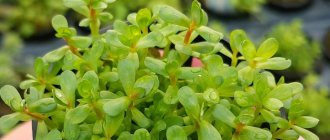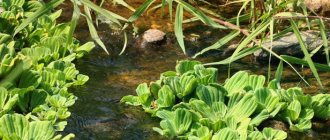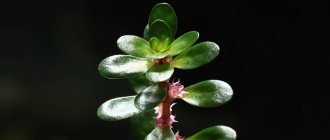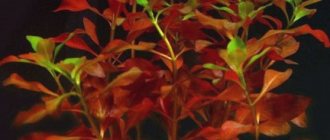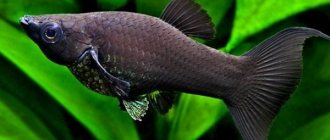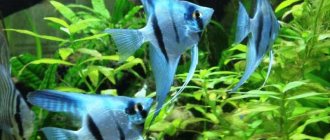Description
This plant has a fairly wide growing range. It is found in both North and South America, as well as throughout Eurasia and Australia. This is mainly the area near the banks of swamps and sluggish rivers. Visually the bushes resemble a lawn. If you care for it properly, you can keep it in both a spacious and compact aquarium.
Eleocharis belongs to the Sedge family and, from a biological point of view, is a full-fledged weed, due to which it reproduces at a fairly rapid pace. Scientists have counted over 260 varieties of this underwater culture, and many of them easily take root in decorative home ponds.
The plant has long, thin and stiff stems. They are mostly green in color but have a brownish upper part. The roots are thread-like, highly branched, thanks to which they easily cling to the soil and stay in it. Therefore, if there is a need to transplant bushes to another aquarium or zone within the same container, then it is better to do this together with the soil in order to avoid damage.
Sizes can vary greatly depending on the variety. There are small species that reach a height of no more than 10 cm, but there is also a sedum up to 40-45 cm.
Some useful tips
To create beautiful scenery from calico grass, it is better to place it in the foreground, then after 1-1.5 months it will transform into a thick lawn. You can also place it along large stones, this will help somewhat soften the visual effect.
You can slow down the upward growth of plantings by trimming them immediately before planting. Then the stems will remain short for a long time and will not require pruning for a long time.
When a plant is planted in the middle part of an artificial pond and it needs to “gain height”, the bush is not cut, which will allow the stems to stretch upward faster.
And in order to form a thick lawn in a short time, it is better to plant several plants at once, at a distance of a couple of centimeters from each other. Then the bluegrass will release lateral shoots and begin to quickly spread throughout the ground.
This video shows in detail the process of planting Sitnyag or Eleocharis in an aquarium.
https://youtube.com/watch?v=VTzPQ0P5QCQ
Content
It is worth noting right away that this plant is not suitable for beginner aquarists, as it requires special care and strict adherence to water parameters. Keeping such flora in an aquarium requires special attention to even minor errors and prompt action. For this reason, Eleocharis is planted mainly by experienced hobbyists.
In order for this plant to grow and delight with its natural beauty, the following is necessary:
Aquarium . It can be of any volume. Some aquarists keep this vegetation in nano-aquariums. Others prefer to use them to create a large aquascape in 100-liter or larger containers;
Water parameters . It is difficult to clearly indicate the indicators, since each variety of this underwater flora has its own characteristic features. But in general, Sitnyag takes root in soft (less than 14°C) and cool (less than 24°C) water with neutral acidity. If, on the contrary, it is warm and hard, this will lead to rapid destruction of the bushes;
Soil . The main thing is that it is of a small fraction. Sand, quartz, small pebbles are suitable. It is important that the plant's roots can grow easily;
Lighting . The duration of daylight hours should be approximately 12 hours, the intensity should be about 0.5 W/l. However, it is much more important that the light be diffused, otherwise algae will appear in the aquarium, which can kill Eleocharis in a short time, blocking its access to food;
Equipment . For this plant, it is advisable to install an external filter, since it effectively purifies the water and removes organic substances from it that can provoke algae growth. Also a desirable condition would be the presence of a supply of carbon dioxide, which has a positive effect on water parameters and increases the growth rate;
Maintaining appearance . A characteristic feature of caring for the plant is that it needs to be trimmed periodically. This is possible in two ways. The first is cutting off the leaves almost to the root. Due to this, the bush will have a low growth and form a denser green carpet. The second is “thinning”. That is, the sheets are cut with scissors in a vertical position. Also, some species are combed using a table fork. This helps to cut off excess shoots.
It is worth noting that if an aquarist wants to successfully maintain this underwater flora, then it is advisable to place “orderlies” in the aquarium with it, who would eat algae, namely algae eaters, theodoxus snails, Amano shrimp, otocinclus, etc.
We recommend reading the article: Japanese Blixa
How to propagate a plant at home
Sitnyag reproduces through ground layering, which is formed on the mother plant. To increase the number of plantings, they need to be separated and transplanted to another location. After some time, the seedlings will take root and begin to grow.
It should be remembered that many species of this culture are extremely susceptible to changes in location and during the first weeks they get sick and waste away. In order not to destroy the young plant, you will need to provide it with the most comfortable conditions during the adaptation period.
Sitnyag aquarium reproduces well by rooting layering.
Reproduction and planting
This plant reproduces through the separation of young shoots. They are located next to the mother bush and do not take root for a long time. Therefore, at first it is better to keep them in an aquarium with a low water level. Until the young shoot forms a rhizome, due to which it can be fixed in the ground.
In many ways, this process is similar to the propagation of ferns, since they also do not produce roots for a long time, and visually it may seem that the bush has simply produced new leaves.
Landing is not particularly difficult. The only important thing is that the plant should not be planted in a new, recently launched aquarium. It is desirable that it has already stood for several months and has a stable “microclimate”. It is worth choosing a place depending on what the aquarist wants from this flora and to what size it grows.
When the place has been chosen, you need to dig a small hole in the ground, plant a bush there and lightly fill it up, without covering the growing point. In the future, it is better not to allow replanting, and if this is done, it will be done together with the area of the substrate to which the plant is attached.
A haircut
It is necessary to distinguish between the following types of haircuts:
almost below zero; thinning When cutting to zero, the plants are cut at the root, leaving a maximum of 2 cm. After this, Eleocharis shoots many arrows, which leads to a thickening of the lawn. This type of pruning can only be done with already well-developed and rooted plants.
Thinning is aimed at slightly adjusting the height of already overgrown bushes. When cutting, scissors should be held straight, almost vertically, leaving no more than 4-6 cm in height.
No matter how much you would like to try yourself as an aquarium lawnmower, you should not trim newly transplanted Eleocharis tufts.
It is quite sensitive to transplantation; it gets sick for up to two weeks in a new place, and pruning can lead to even greater stress, and sometimes even to the death of the bushes.
Kinds
This plant has hundreds of varieties found in different parts of the Earth. However, the following types are mainly used in home ponds.
Eleocharis mini
It is distinguished by the smallest size in its family. It can be seen quite rarely in aquariums. It is mainly planted in the foreground, as it forms a thick and beautiful green carpet.
It stands out from other species due to its curled leaves, reaching no more than 3-4 cm in length, and the same small stems. It grows extremely slowly, so there is practically no need to trim it or carry out any similar operations to maintain its attractiveness.
The optimal temperature is 15-27 degrees, acidity is 5.5 - 8 pH. To accelerate growth, it is recommended to apply liquid fertilizers and an abundant supply of oxygen. According to the conditions of detention, it is unpretentious, but does not tolerate dirty water well.
Tiny Sitnyag (dwarf) or Eleocharis parvula
Such a varied name is explained by the fact that this plant is the most common variety among aquarists. It is relatively unpretentious and makes it possible to easily recreate an imitation of a green lawn in an aquascape. Planted either in the front or in the center. This depends on the size of the container.
It reaches a height of 10 cm, but no more than that. On average, this figure is about 5-6 cm. The leaves are thin and have a bright, rich color. Bushes do not need bright light to grow. On the contrary, they may become covered with algae, which is not recommended at all.
To maintain an attractive appearance, it is periodically necessary to thin out the plantings and trim the leaves.
Giant (xingu)
The natural habitat is the reservoirs of Mexico and the USA. Unlike other members of the family, the giant soothsayer grows quite large, up to half a meter. Therefore, it is only suitable for large aquariums, where it is planted at the back or side wall.
It is in demand among aquarists because it does not require special conditions and is rarely touched by fish. But for good growth, you need to maintain a temperature of 20-24 degrees, and an acidity of 6.5-7 pH.
Viviparous (viviparous)
It is distinguished by a light green tint and leaves up to 10 cm. In aquariums, it is planted in the background due to the fact that one bush can grow up to 40 cm and forms dense and interesting thickets. This plant has a characteristic feature that lies in its wavy and curved leaves. If other varieties of this family have exclusively straight stems and resemble a lawn, then this species looks as if it was deliberately confused.
It reproduces through the separation of young shoots appearing on the flower shoot. When the young bush is formed, it is separated and kept in a quarantine container with a low water level. It will enter the general aquarium only with the appearance of the root system.
The optimal temperature is 18-22°C, soft water and neutral acidity. Daylight hours should not exceed 12 hours.
Acicular (acicularis)
The name of this plant is explained by the fact that it has absolutely no leaves. Thickets are formed from small stems with a sharp tip. The light green bushes reach a height of 15 cm. Flowers may appear in the upper part.
Eleocharis acicularis is kept in small or nano-aquariums. In large containers their growth is significantly reduced. A temperature of 21-24°C and an acidity of 6.4-7.5 pH are best suited for it. Medium hardness is suitable.
The mixture can be used as a primer. It should contain garden soil, sand and clay with a layer of 2-3 cm. With such a substrate, the thickets will begin to show themselves the fastest.
In addition, this flora must be protected from direct sunlight. The duration of daylight is about 12 hours, the intensity is 0.5 W/l. Fluorescent lamps are best.
Photo of Eleocharis
Some interesting photos of this plant. Professionals use it to create a lawn. Not only does the lawn require mowing, but also thinning.
Haircut of the Swampwort in the aquarium.
Lawn from Eleocharis
Sintyag Needle
The second plant, Calamus (Acorus Gramineus), does not grow under water at all, but is grown on land, in paludariums and terrariums. I will write about Calamus Zlakov in another Aquarium blog post. These interesting plants were purchased spontaneously at the market.
While looking through sites describing Eleocharis Acicularis (Sintyaga Acicularis), I noticed that most of the texts were simply copied from each other, with the exception of minor changes. I still haven’t found a real description or photo of how to properly plant and grow Bolotnitsa. It turns out that Eleocharis Acicularis is not a very common plant among aquarists, at least among beginners. I'll try to grow and propagate my own copy. At the moment it is growing slowly; in two weeks, almost no growth has been noticed in the uncircumcised plant.
Leave your comments if you have questions or know something interesting about this plant. I'm also ready to listen to criticism.


